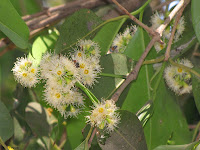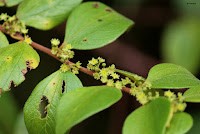While you are reading this post, one thing
is going in & coming out of you right now. Air such an important factor. It
is the layer of gases, called Atmosphere, which keeps the Earth warm. Without these
gases, the temperature on earth will not be stable.
While the oceans contain most of the Earth's
water, water also exists as ice and water vapour. Air is important because it
helps water move between these states in a process called as the Water Cycle. We
all know that when heated by the sun, surface water evaporates into the air and
becomes water vapour. As temperatures drop, water vapour forms clouds as it
condenses. Clouds return water to the Earth in the form of rain or snow,
usually far from the water source. The water cycle ensures that life around the
planet receives the water it needs. It also helps replenish streams, rivers, lakes
and other waterways.
Being such an important resource, do we respect
or value the Air we breathe? Not really… It is sad to know that majority of pollution, be it
of air, water or soil, is from man-made sources. The single most harmful source
of air pollution is the unchecked burning of fossil fuels by human. Fossil
fuels are the non-renewable sources of energy such as crude oil, petrol,
diesel, coal etc. & are used in almost every process of industrialisation, manufacturing, transport and energy generation. In rural areas, a major source
of pollution is the practice of unchecked crop burning. Another source of
man-made pollution is military resources such as nuclear arsenal and chemical
weaponry.
The consequences of Air Pollution are hazardous
and can be fatal too! The pollutants that cause air pollution in our atmosphere
are seriously damaging the protective ozone layer. When the ozone layer gets
depleted the harmful ultraviolet B radiation reaches the surface of the earth and causes
skin cancer and eye damage among humans. The deadly combination of Smoke and Fog, Smog is extremely harmful to humans and the entire
environment. It can lead to diseases such as cold, flu, irritation of the eye,
asthma and in the long term even lung cancer. Another disaster Acid Rain is
caused when a chemical reaction occurs between air pollutants and water &
oxygen very high in the atmosphere. Pollutants such as sulphur dioxide and
nitrogen oxide are water soluble and mix with the water in the atmosphere and
precipitate as acid rain. The acidic nature of this rain causes severe damage
to the plants, animals and the soil.
So how to prevent this catastrophic
disaster? & most importantly, how to clean the
air??? We will discuss that for sure! But before that, let me tell you another
virtue of Air.
Air also plays a vital role in recycling
one of Earth’s most important substances: Carbon. Carbon is important because We
all are a carbon-based life form and we need it to survive. Carbon sources
include fossil fuel combustion, the decay of dead animals and volcanoes.
Animals and humans also release carbon dioxide into the air when they breathe.
Through the process of photosynthesis, plants extract carbon dioxide from the
air and use it to produce energy. They also release oxygen during this process.
When people and animals eat the plants, they ingest carbon and produce the
energy they need to live. When they die, their bodies decompose, causing carbon
to go back into the air as this endless cycle (Carbon Cycle) repeats itself.
Thus, trees are able to absorb Carbon dioxide (CO2) and Carbon
monoxide (CO) from our atmosphere and reduce the ‘greenhouse effect’, creating
a less polluted, more sustainable world for us and our future generations. It
is shown that in one year, an acre of mature native trees absorbs the same
volume of carbon monoxide as produced from a 42000 km car journey! Aside from
cleaning the air for us, trees supply us with fresh oxygen to breathe. Forests
have proven to be an invaluable asset when it comes to improving air quality
and reducing harmful pollutant levels in the atmosphere.
 Trees planted in an urban environment can
not only counteract the warming effects concrete and buildings have on the
environment (known as the Urban heat island effect), but they have also been
shown to clean the air and absorb harmful airborne particulates (particularly
small particles which are a major health hazard), gaseous pollutants and toxins
such as nitrogen oxides, ammonia and sulphur dioxide through their leaves, bark
and roots. Trees along urban roads & highways can reduce the presence of
fine particulate matter in the atmosphere within a few hundred metres of the
roadside verge. This improves the air quality in the microclimate around the
trees and contributes to a healthier and cleaner environment overall. This is
why we should try our best to ensure that our forests aren’t being lost to
deforestation.
Trees planted in an urban environment can
not only counteract the warming effects concrete and buildings have on the
environment (known as the Urban heat island effect), but they have also been
shown to clean the air and absorb harmful airborne particulates (particularly
small particles which are a major health hazard), gaseous pollutants and toxins
such as nitrogen oxides, ammonia and sulphur dioxide through their leaves, bark
and roots. Trees along urban roads & highways can reduce the presence of
fine particulate matter in the atmosphere within a few hundred metres of the
roadside verge. This improves the air quality in the microclimate around the
trees and contributes to a healthier and cleaner environment overall. This is
why we should try our best to ensure that our forests aren’t being lost to
deforestation.
We all know that Air contains 21% Oxygen. And
the fact we don’t know or underestimate is that Air contains this much oxygen
is not because the Earth provided us the atmosphere with that composition, but
because trees and plants produced oxygen for over 2 billion of years from Carbon
dioxide.
Our Air is a very precious resource.
People, animals, plants and birds all depend on clean air to live. Choices we
make every day can make a positive difference to our air quality, both indoors
and out. Planting native trees is a cost-effective way to tackle urban air
pollution, which is a growing problem for many cities. And one must not forget, Trees help us
breathe! :)





















































